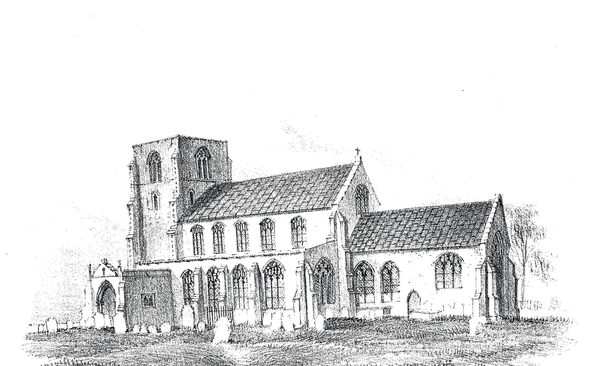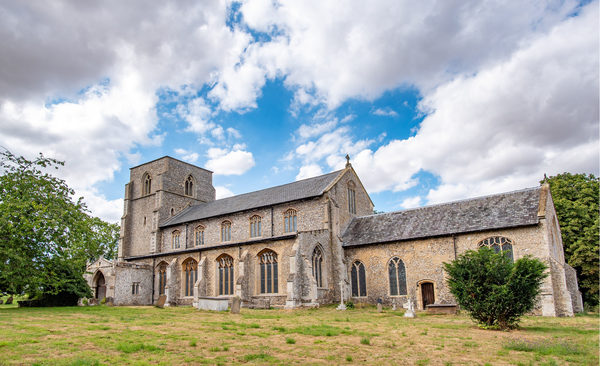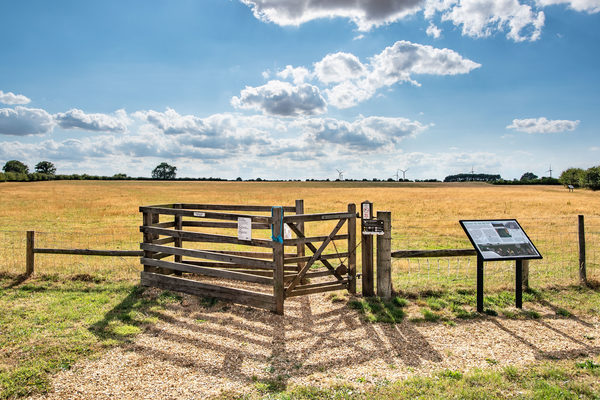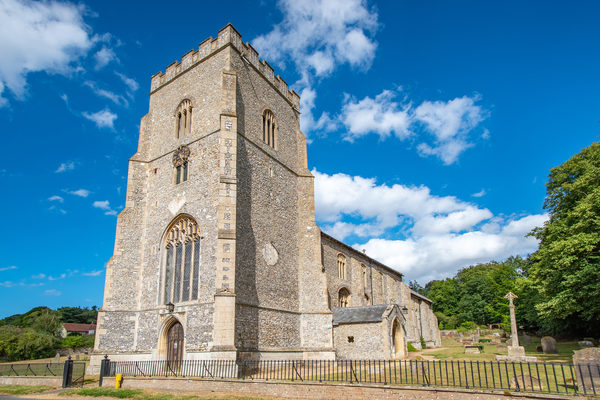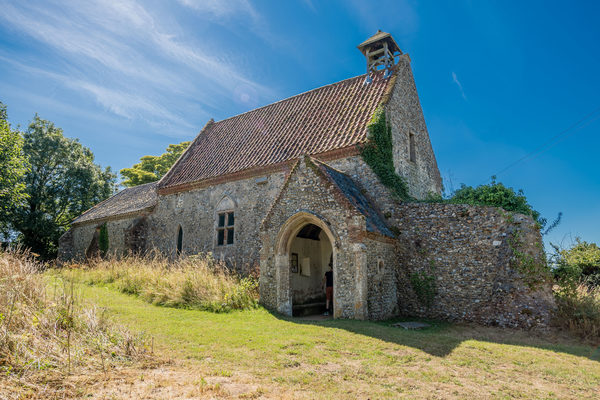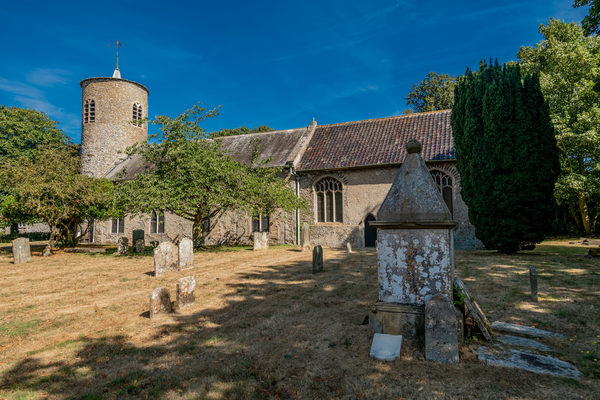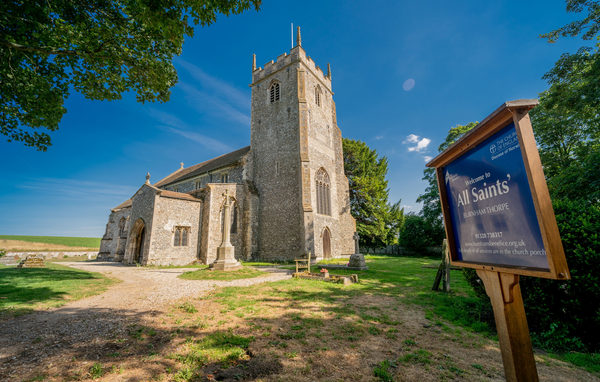A church has probably stood on this spot for over a thousand years, although later work has obscured the very early building. The medieval features are supreme here. The earliest recognisable pieces are two Norman stones - one is reset as a riser in the belfry stairs, and the other is on the outside of the church, halfway along the South side.
The tower is early 14th century and remains substantially unaltered. Many such towers had parapets added later, but here we see a plain top. Some of its bell frame is still the original oak. It had a church steeple of wood in the 17th century. The present 5 bells were recast in 1826 by William Dobson of Downham Market. The continuous stringcourse shows that the North and South aisles were built at the same time as the tower. There is a fine West window with reticulated tracery in the tower and windows in each aisle of the Decorated Period, c.1330.
The porch is deliberately large because parts of some medieval services such as weddings were held there. It is also c.1330. Above the entrance is a niche containing a modern statue of Maria Regius - Mary Queen, the patron saint of this church. This statue is flanked by the crowned MR. This emblem, 'MR' was also incorporated in the handle of the 15th century key.
The South window are large Perpendicular Period ones added in 1440, when the clerestory windows were also added.
The chancel was built in the late 13th century when the Castle Acre Priory was the Patron. The stonework of the East window is of this period. A later window has been inserted on the South side.
The vestry is a very early one added to the North side of the chancel soon after 1400. Its windows are especially interesting.
The roof of the nave is a glorious example of hammer beam construction. In 1412 John Buckenham left in his will 6s.8d to "covering the church", which indicates that work was going on then. It is probably slightly later because it bears the arms of the Black Prince after 1415. The shields include the Instruments of the Passion, the Chalice, and a triple crown.
The hammer beams are carved in the form of angels upon which rest the arch-braces that take the weight of the roof. The angels themselves are on wall posts supported by corbel brackets. When the angels were being restored in 1958 lead shot was found embedded in the wood; this supports local folklore that Cromwell's Roundheads billeted here overnight and used the angels for target practice.
The aisle roofs are also a similar date and have lovely carved spandrels. Look closely for the animals and birds carved in the South aisle roof, which include a unicorn and a pelican.
The piers and arcading are part of the same building campaign in the early 1400s. They have stone seats around each pier, reminding us of the time when there were no benches. Above the chancel arch there is a window to light up the angels in the roof early in the morning.
The rood beam in medieval times was a little lower than the modern one that now crosses the chancel arch. The old stone stairs are still there on the South side.
The screen across the chancel arch was made shortly after 1400. It has lost most of its original painting, but does possess doors that can still be used and are an unusual feature. Above the doors is a most elegant arch and there is lovely tracery all across the top of the screen. THE PULPIT is about the same date. It is hexagonal in shape on a wine glass type stem and is very slender with a narrow rim at the top. Some red and green paint has survived some 575 years of use.
The piscina in the North aisle has the added interest of a consecration cross in the back wall of the niche above the flower drain.
The royal arms are for King George II and the parish records show that they cost £12.15.6d in 1740, of which £7 was for the wood. The parish bier is a particularly early one, inscribed with its date, 1688. Again we find it cost £1.6.6d.
The chest kept these records until recently. The larger one is thought to be c.1400. It has 5 locks - 2 for the churchwardens, 2 for the parish overseers, and 1 for the parish priest, and it needed 4 strong men to lift the lid.
The organ is made by Bevington & Sons of London and earned a 1st class medal at the Paris Exhibition of 1855. It is a fine quality instrument sited in the nave and well suited to enhance the congregation's singing. This is in contrast to the later and much louder organ in the chancel of North Creake Church. This was restored in 1987 by Holmes & Swift.
The font is raised up on two steps with carving on the vertical part of the top step. There is a lovely stem to the font, but the 8 panels of the bowl have been totally defaced. It showed the seven sacraments of the church and was made about 1450. If you look up to the roof, you can see the pulley that was used to raise the original font cover. The present cover is much smaller and has one stage missing.
A stone coffin lid of the 13th century now lies in the North aisle. It has a four petal cross at each end with a sign of eternity in the centre.
Monumental brasses:
1. Near the door is a well engraved half figure of a priest without any inscription. This is a London made brass c.1400 and is thought to be John Felbrygg, Rector of Coltishall, and not a rector here.
2. In the centre aisle there is a fine brass for John Norton, Clerk, with his parents. He died in 1509, but the engraving was made a few years later, reusing another brass that includes a bishop's crozier.
3. A missing brass near NO.2 leaves a remarkable indent of a priest under an elaborate canopy. A tinker, named David Dent, was apprehended in Norwich in 1754 and confessed to stealing several pieces of brass from South Creake Church.
4. A shield with the arms of Wheatley impaling Pepys and missing inscription was Clemence, wife of William Wheatley. She died in 1565 and her maiden name was Pepys. The famous diarist was descended from her uncle. Samuel Pepys wrote about "my Norfolk cousins".
The stained glass. West window near door - 3 Flemish panels from early 16th century show Abraham sacrificing Isaac, the scourging of Christ and the Holy Trinity. In the corner is the emblem for G.King & Sons of Norwich, who have restored the medieval glass in this church. South aisle East window has censing angels in tracery from original glazing c.1340. Then there is the Bethrothal of the Virgin (Swiss 16thC) and the Coronation of the Virgin. Chancel East window has a modern St Margaret and St Mary in intersected tracery. North aisle East windoe has a much restored figure of Christ on the cross. The canopy is early 14th C when perspective was a difficulty. North windows have 15th C angels with some harps in tracery and larger saints in main lights, e.g. St James the Less, St James the Great (hat and staff), St Andrew (cross saltire), St Helen (cross, crown), St Agatha. North aisle West window has Christ in Majesty with green robe and white mantle, c.1330-40, and many other pieces. Clerestory - 3 windows have 6 angels in each which look wonderful through binoculars.
